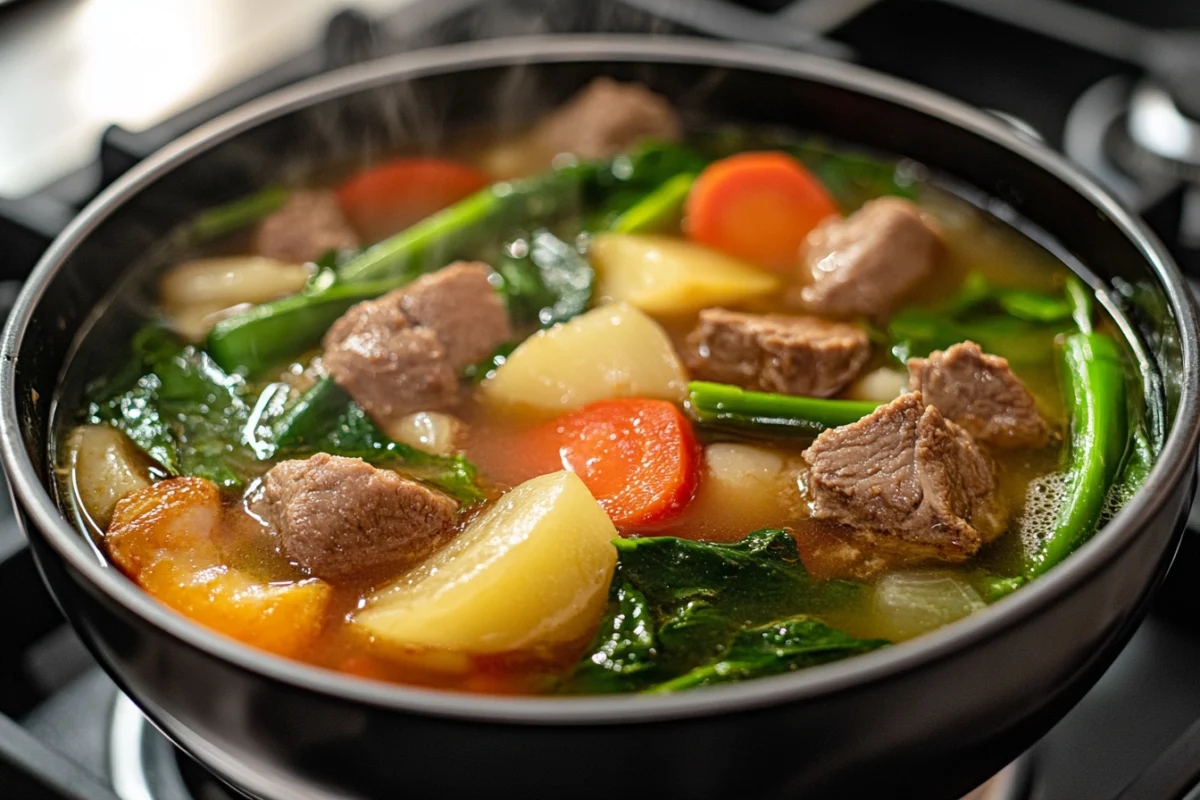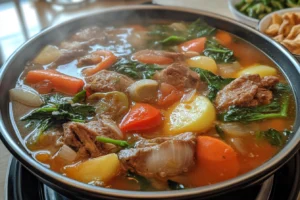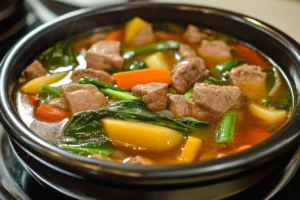Sinigang recipe is a beloved Filipino dish, known for its tangy and savory broth. It is considered one of the most comforting dishes in Filipino cuisine and is enjoyed throughout the Philippines. This sour soup typically features a variety of vegetables and meats, with the key ingredient being the souring agent traditionally tamarind.
- Originating from the Filipino culinary tradition, sinigang is often a staple in homes across the country.
- The dish is served as a family meal, ideal for sharing, making it a popular choice for gatherings and celebrations.
- Sinigang offers a balance of flavors: sour, salty, umami, and sometimes even a hint of sweetness.
In addition to the classic beef sinigang (sinigang na baboy), there are several variations of sinigang based on the protein used shrimp (sinigang na hipon), fish (sinigang na isda), and even beef and chicken.
A Brief History of Sinigang
Sinigang has a deep historical significance in Filipino culture, evolving through centuries of local and international influences. The dish is believed to have originated from early Filipino souring practices, using locally available fruits and herbs.
- Early Filipino settlers used tamarind, guava, and calamansi to create sour broths, which eventually became sinigang.
- The dish likely has influences from Indonesian and Malay cooking traditions, where sour soups are also popular.
- Over time, sinigang adapted to local tastes, with regional variations emerging, making it unique in every Filipino household.
Despite its long history, sinigang remains an essential part of Filipino daily life, reflecting the love of fresh, vibrant ingredients and the importance of communal dining.
Why Sinigang is Loved by Filipinos and Beyond
Sinigang’s popularity extends beyond the Philippines, making it a cherished dish among non-Filipinos as well. It embodies the essence of Filipino cuisine: simple, flavorful, and comforting.
- The dish provides a refreshing contrast to heavier meals due to its tart, light broth and crisp vegetables.
- Health-conscious individuals love sinigang because it’s low in fat and packed with nutrient-rich vegetables and antioxidants.
- The versatility of sinigang allows it to be made with various meats and vegetables, catering to a wide range of preferences and dietary needs.
Sinigang’s distinct, tangy flavor is a key reason why it resonates with so many people, from Filipinos overseas to international food enthusiasts.
Ingredients and Preparation
Essential Ingredients in a Traditional Sinigang Recipe
To create the perfect sinigang, it’s essential to gather the freshest ingredients to build a flavorful and balanced broth. Here are the essential components:
- Vegetables:
- Kangkong (water spinach), okra, labanos (radish), eggplant, and sitaw (string beans) are the most common vegetables used in sinigang.
- These vegetables not only add texture but also enhance the freshness of the broth.
- Meats:
- Traditionally, beef is the most popular meat used in sinigang (sinigang na baboy), but shrimp (sinigang na hipon), beef, fish, and even chicken are common variations.
- The choice of protein plays a significant role in the flavor profile of the dish.
- Tamarind:
- The souring agent, tamarind, is what gives sinigang its signature tanginess. You can use fresh tamarind pods, tamarind paste, or sinigang mix.
- If tamarind is unavailable, alternatives like calamansi (Filipino lime) or green mango can be used for a slightly different flavor.
- Aromatics:
- Onions, garlic, and tomatoes provide the base flavor of the broth.
- Ginger adds warmth and depth, balancing the sourness.
Alternative Ingredients for Customizing Sinigang
Sinigang is highly adaptable, allowing you to substitute ingredients based on personal taste or availability:
- Souring agents: If fresh tamarind is hard to find, you can substitute with other fruits like green mango, calamansi, or even bilimbi. These alternatives offer a unique flavor twist while maintaining the signature sourness of sinigang.
- Vegetarian options: For a vegetarian or vegan version of sinigang, replace the meat with plant-based proteins such as tofu or tempeh. You can also make a vegetable sinigang by focusing on the vegetables and adding miso or soy sauce for depth.
- Additional flavors: Experimenting with fruits like pineapple or guava can add a subtle sweetness to balance the sourness.
How to Make the Perfect Sinigang Broth
Making sinigang broth requires patience and careful attention to balance. Follow these steps for a flavorful, aromatic broth:
- Start with a flavorful base:
- Sauté garlic, onions, and ginger in oil until fragrant.
- Add tomatoes and cook until softened to extract their natural sweetness.
- Add your choice of meat:
- If using beef, use cuts like beef belly or shoulder for a tender result. Brown the meat to develop flavor before adding water.
- Create the broth:
- Pour in water (around 6-8 cups) and bring it to a boil. Simmer for 45 minutes to an hour, depending on the meat used.
- Add the souring agent:
- Once the meat is tender, add the tamarind, or other souring agent of your choice. Let it cook for 10-15 minutes to extract the flavor.
- Season the broth:
- Add fish sauce or salt to taste, adjusting the saltiness. Taste as you go to ensure the perfect balance.
- Add the vegetables:
- Finally, add your choice of vegetables. Keep them tender but crisp, and avoid overcooking to maintain their vibrant color and texture.
- Adjust the seasoning:
- Taste the broth again, adjusting the sourness, saltiness, or sweetness to suit your preference.
Common Mistakes to Avoid While Making Sinigang
Even though sinigang is a straightforward dish, certain mistakes can affect the final taste and texture. Here’s how to avoid them:
- Overcooking vegetables: Vegetables like kangkong and sitaw should remain crisp-tender, not mushy. Add them towards the end of cooking to avoid overcooking.
- Too much sourness or salt: The key to a perfect sinigang is balance. Start with a small amount of souring agent and adjust as needed. Similarly, season gradually to avoid making the broth too salty.
- Failing to remove impurities: When simmering meat, scum and impurities rise to the surface. Skim these off regularly to ensure a clean and clear broth.
Cooking Techniques for Different Proteins
The protein used in sinigang greatly impacts its texture and flavor. Here are some tips for each protein:
- beef (Sinigang na Baboy):
- Use beef belly, beef ribs, or shoulder for tender cuts.
- Brown the meat first to enhance the flavor of the broth.
- Shrimp (Sinigang na Hipon):
- Add shrimp last to avoid overcooking. Shrimp cooks quickly, and should be added just 5-7 minutes before the broth is done.
- Fish (Sinigang na Isda):
- Use delicate fish like bangus (milkfish) or tilapia.
- Add fish towards the end to keep it from breaking apart.
- Chicken (Sinigang na Manok):
- Use chicken thighs or drumsticks for more flavor. Simmer for 30-40 minutes until tender.
Variations of Sinigang
Regional Variations of Sinigang
Sinigang varies greatly depending on the region, with different provinces and regions offering their own unique take on the dish.
- Sinigang na Baboy: This is the most popular version, using beef as the protein. It’s often made with beef belly or ribs for a rich, flavorful broth.
- Sinigang na Hipon: A lighter version, typically made with shrimp. The broth is more delicate, and the shrimp adds sweetness.
- Sinigang na Isda: Fish is used as the protein in this variation. Common choices include bangus or tilapia, which provide a mild, light taste.
- Sinigang na Baboy sa Bayabas: In some regions, guava is used as a souring agent in place of tamarind, offering a unique, tropical flavor.
Modern Sinigang Variations
While traditional sinigang is a time-honored recipe, there are exciting contemporary twists on this dish.
- Sinigang sa Miso: Adding miso paste to the broth adds depth and umami. It pairs especially well with fish or seafood.
- Sinigang with Pineapple: For a sweet and sour variation, adding pineapple creates a tropical twist.
- Sinigang sa Santol: This variation uses the santol fruit (cottonfruit) as the souring agent, giving it a unique flavor that’s slightly sweet and tangy.
Serving Sinigang
How to Serve Sinigang
Sinigang usually serves as a hearty, one-pot meal that you can enjoy on its own or pair with rice for a more filling dish. Here’s how to serve sinigang properly:
- Rice: Traditionally, sinigang is eaten with steamed white rice. The flavorful broth and tender meat or seafood are perfect complements to the neutral taste of the rice.
- Side Dishes: In some households, sinigang is served with side dishes like grilled fish, fried tofu, or fermented shrimp paste (bagoong) to enhance the flavor.
- Serving Style: Sinigang is usually served in a large bowl, allowing everyone to help themselves. People typically use a ladle to serve the broth and ingredients.
- Garnish: Garnishing with fresh herbs such as spring onions or a squeeze of calamansi can enhance the flavor and presentation of the dish.
The vibrant colors of the vegetables and the rich broth make sinigang a visually appealing dish as well as a delicious one.
Best Side Dishes to Pair with Sinigang
While sinigang itself is satisfying, pairing it with the right sides can elevate the meal. Here are some popular side dishes that complement sinigang:
- Fried Fish: Crispy tilapia, bangus (milkfish), or bangus belly are commonly served alongside sinigang.
- Grilled Meats: Grilled liempo (beef belly) or baboy (beef) are great options for a smoky contrast to the tangy broth.
- Rice Cakes: Kakanin (Filipino rice cakes) like biko or sapin-sapin can add a slightly sweet counterpoint to the sourness of sinigang.
- Bagoong: You can serve a small dish of fermented shrimp paste as a dip to enhance the savory flavor of sinigang.
Frequently Asked Questions (FAQs)
Can I use other meats besides beef for sinigang?
Yes, beef is the traditional protein in sinigang, but you can use shrimp, fish, beef, or even chicken instead. Each protein brings its own flavor to the broth, with shrimp offering a lighter taste, and beef creating a richer, heartier broth.
How do you make sinigang less sour?
To make sinigang less sour, simply use less of the souring agent. You can also balance the sourness with a bit of sugar or by adding sweet vegetables like tomatoes or sweet potato. Taste as you go and adjust according to your preference.
How long does it take to cook sinigang?
The cooking time for sinigang varies depending on the type of meat used. For beef, it generally takes 45 minutes to 1 hour to cook until the meat is tender. For shrimp or fish, the cooking time is much shorter—usually 15-20 minutes.
Can I prepare sinigang in advance?
You can prepare sinigang in advance and store it in the refrigerator. The flavors often improve after sitting overnight. When reheating, make sure to add extra broth or water if necessary to maintain the proper consistency.
Is sinigang spicy?
Sinigang is not typically spicy, as the primary flavor comes from the sourness of the broth. However, if you enjoy a bit of heat, you can add bird’s eye chilies (siling labuyo) to the soup or serve them on the side for an extra kick.
Sinigang Recipe Variations for Special Diets
Vegan and Vegetarian Sinigang
For a plant-based version of sinigang, you can create a flavorful, rich broth using vegetable stock and replacing the meat with tofu, tempeh, or just more vegetables. Here’s how to make a Vegan Sinigang:
- Use vegetable broth as the base for the soup.
- Replace the meat with tofu, tempeh, or mushrooms for texture and umami flavor.
- Include vegetables like kangkong (water spinach), sitaw (string beans), labanos (radish), and eggplant.
- Add tamarind or calamansi for the signature sour taste.
Low-Sodium Sinigang
To make a low-sodium version of sinigang, consider these modifications:
- Use low-sodium soy sauce or fish sauce instead of regular fish sauce to control the salt content.
- Avoid added salt and adjust with other seasonings like fresh herbs or a squeeze of calamansi for a boost of flavor.
- Use fresh tamarind instead of sinigang mixes, which often contain added sodium.
Keto Sinigang
For a keto-friendly version of sinigang, you can replace the rice with cauliflower rice or omit the rice altogether. Here’s how to adjust the recipe:
- Replace the vegetables with low-carb alternatives like zucchini, bok choy, or mushrooms.
- Use fatty cuts of meat like beef belly or beef shank for added richness and texture.
- Avoid high-carb vegetables like potatoes and corn.
Conclusion
Sinigang is more than just a dish; it’s a Filipino tradition that brings families together. Whether made with beef, shrimp, fish, or a mix of fresh vegetables, sinigang offers a perfect balance of flavors that everyone can enjoy. From its Filipino roots to modern twists, sinigang remains a comforting and flexible meal.
By learning about the key ingredients, cooking methods, and different versions, you can make your own version of sinigang, suited to your taste or diet. The sour, savory, and fresh flavors of sinigang will continue to win over anyone who tries it, making it a favorite dish for many generations.
If you’re interested in learning more about making flavorful broths, take a look at this recipe guide for corn nuggets, which also features hearty recipes.



